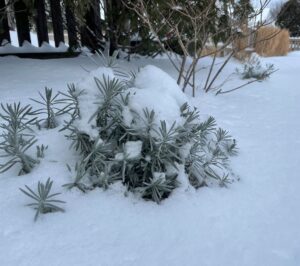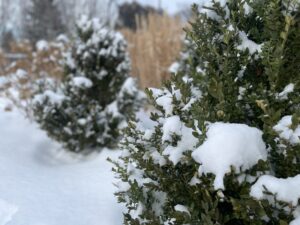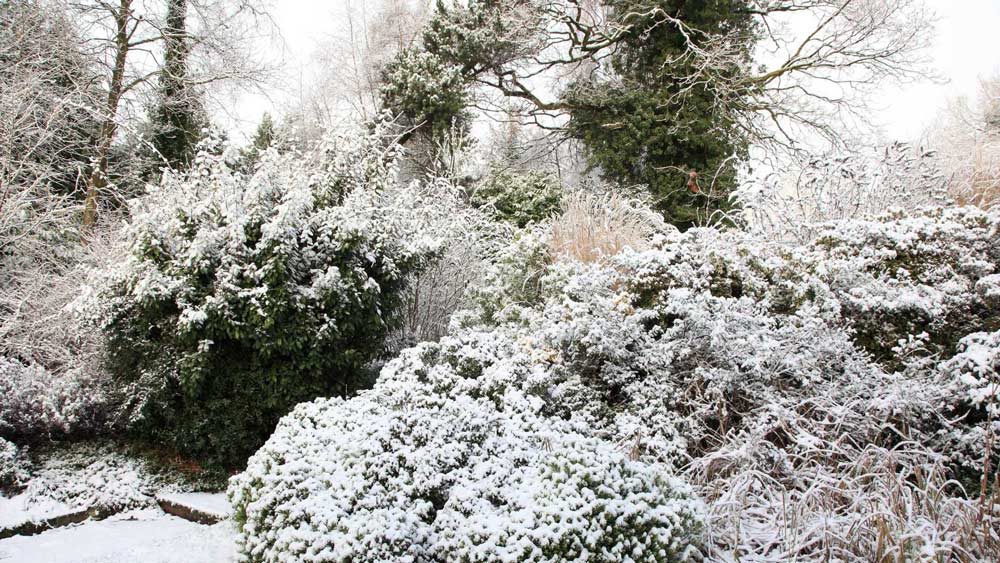Temperatures have consistently been below freezing and periodic snowstorms are spinning through the area. Ladies and Gentlemen, we are in the heart of winter! Looking out your window, you may be wondering how all this cold weather and heavy snow cover could be good for your garden.

The truth is snow is beneficial for your landscape!
It acts as a winter mulch, providing insulation from the harsh winds and minimizing the effects of the freeze thaw cycle. Snowpack slows the deep, subgrade soil freezes and reduces the chances that perennials you divided in the fall will heave and expose their roots to the elements. Additionally, snow can also help to prevent soil erosion by adding a layer of protection over the soil, which can be especially important in areas that get a lot of wind or rain.
Snow can be an insulator for plants
Snow acts as a natural insulator for plants, especially during the harsh winter months. The air trapped between snowflakes creates a buffer, preventing the ground from getting as cold as the air above. This insulation is particularly beneficial for newly planted seeds, such as grass. For instance, the effect of snow on newly planted grass seed can be positive, as the snow protects the seeds from extreme cold, allowing them to remain dormant until the right conditions for germination arise. Once temperatures warm and the sun begins to shine, the snow melts and our plants use that water to jump start the spring growing season! Snowpack is a good thing!
 But the snow looks like it’s breaking my plants branches!
But the snow looks like it’s breaking my plants branches!
OK, so snow on the ground is great, but what about the snow that is bending my arborvitae or weighing my boxwood branches down to the ground? While heavy snow is not ideal, plants that we use in our gardens have evolved over time and have adapted to the weighty snows that winter may bring. While your shrubs may look stressed, the snow will eventually melt from their bent branches and they will reclaim the form you are accustomed to seeing.
Which plants do best with the snow?
Different plants have varying levels of resilience to snow and cold. Evergreens, for instance, have evolved to bear the weight of snow on their branches, while many deciduous plants shed their leaves in preparation for winter. However, some plants, especially those not native to snowy regions, might struggle under the weight and cold of snow. The effects of compacted snow on plant life can be detrimental, as compacted snow can limit the amount of air reaching the soil, potentially suffocating the roots. It’s essential to know the types of plants in your garden and their tolerance levels to ensure they thrive even in snowy conditions.
How to get excess snow off plants and branches
If you can’t help yourself and you feel you have to remove the snow and “save your plants”, do so slowly and when temperatures are not bitterly cold. The colder the air temperature, the more susceptible branches are to snapping, thus negating your attempts to “help” your shrubs.
Here are a few more tips
1. Brush off the snow
If the snow is heavy and wet, try to gently brush it off of the branches and stems of your plants and trees. This can help to prevent the weight of the snow from breaking branches or bending stems.
2. Use stakes or supports
If you have small trees or shrubs, you can use stakes or supports to help hold them up and prevent them from being bent or broken by the weight of the snow.
3. Add mulch
Adding a layer of mulch around the base of your plants and trees can help to insulate the roots and prevent them from being damaged by freezing temperatures.
4. Watering
If you know that snow is coming, watering your plants before the snow falls can help protect them, as the frozen water in the cells will expand less and cause less damage.
5. Cover plants
If you have tender plants or potted plants, you can protect them by covering them with a tarp or burlap.

As snowfalls continue to roll through the area, please take caution to not stack snow on top of or around your plant material. Large piles of snow resting on your plants add extra weight and increase the likelihood of winter damage. Those snow mounds can also allow resource starved rabbits and deer to reach higher into the plant possibly causing more foliage damage than during the growing season.
As our winter persists, enjoy the changing seasons, remember that your shrubs will survive and embrace all the beauty that winter has to offer!









